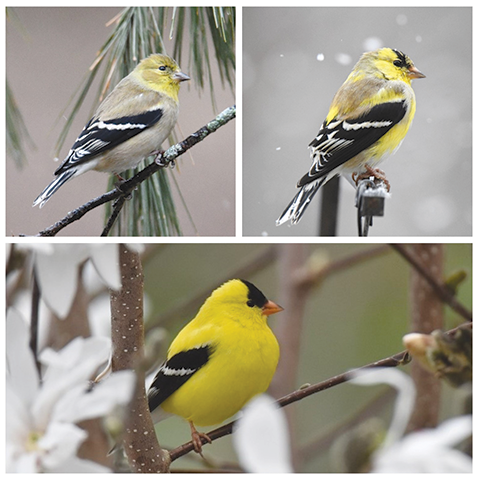
The American goldfinch is shown with his winter plumage, molting in the spring and then in his breeding plumage by summer. He will molt again in the fall to his winter plumage.
When we were little, my mom often told us stories about her childhood growing up in Cotton Hollow in Glastonbury. It was a pretty idyllic spot, and we loved to go there as kids and head down to the brook and the old mill. We explored the house poised on the side of the hill where there was always a fresh batch of fudge and the melodious song of my gramma’s pet canary. Canaries were popular pets back in the day and considered the workhorse of captive songbirds. They are pretty birds and fill silences with their impressive song.
When my mom was a young teenager, her uncle Reginald moved in with her family after he returned from serving in World War I. He had enlisted as a gentle artist and came home with demons he could not shake. My mom described his presence in their home. He continued to be a quiet man, but at dinner he would mix all his foods in a heap on his plate. The ketchup would be comingling with the peas and meatloaf topped with a dollop of canned salmon and some random soup. He continued to paint but could not see any project to fruition. He would paint a lovely woman and finish her off with the feet of a chicken. There was something he had endured in the trenches in The Western Front that would not leave him as he reacclimated to civilian life. He spent his evenings smoking in an easy chair in the kitchen next to the family canary. The canary would sing its heart out most of the day and at night. To let the canary, get some shut eye, they would cover his cage with a sheet. As darkness fell the only light would be from the end of my mom’s uncle’s cigarette as the ash grew and teetered. I like to think that Uncle Reginald and the canary were a kind of soul mate, each unable by physical or emotional baggage to live the life that had been set before them. The canary should have been free to fly in the wild, and the uncle should have been free of the horrors of war once he had put in his time. But this was not to be.
This time of year, I think of Uncle Reginald even though I did not know him, and I think of the canary that shared his space. Locally in the birding world, we have a bird which appears at our feeders which is affectionately called the “wild canary”. These are American goldfinch which most of the year are in drab olive-green plumage, eating seeds by the roadside and visiting yards to forage. Around this time of year, birders put out their thistle feeders in droves to attract goldfinches as this is the time of their extremely impressive molt. Both male and female goldfinches are growing new feathers and the males are coming in to show off their breeding plumage. Patch by patch the male is becoming a brilliant yellow and black, and it is impossible not to swoon when he visits my feeder. I suspect the female goldfinches are feeling the same way. In another month, the molt will be complete, and they will pair off as they head off to the fields and roadsides.
I guess our American goldfinches are lucky to live here in New England, where we peer at them from our windows day after day in the spring. They are free to come and go as all wild birds should be. At least unlike my gramma’s canary, they were not raised for the pet trade and not confined to cages or, even worse, used in mines to detect carbon monoxide. It seems like canaries got the short end of the stick for lots of reasons, one their beauty, another their lyrical song. And maybe my uncle Reginald got that same short stick by feeling the need to sign up for a war which he did not know how to fight or to leave behind.